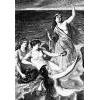
The Sirens had bodies of a bird
and beautiful human heads
tripod, c600-570 bc |
Today, Sirens (Seirenes) are imagined as sweet, alluring singers in
the shape of a woman or mermaid. In early Greek mythology, sirens were
actually prophets and described as having bodies of a bird and beautiful
human heads. Some ancient myths say the sirens are the daughters of the
river Achelous and the Muse of dancing, Terpsichore
the "Whirler."
The numbers and names of the sirens are inconsistant in classical mythology.
Homer mentions two Sirens, but only names one, Himeropa ("arousing face").
Elsewhere, there was said to be three of them called Thelchtereia ("enchantress"),
Aglaope ("glorious face"), and Peisinoe ("seductress"). Finally, in Italy,
they were named Parthenope ('virgin"), Leucosia ("white goddess"), and
Ligeia ("bright-voiced").
Sirens are skilled musicians both vocally and instrumentally. According
to the writers who claimed there were three of them, one sang, one played
the lyre, and one played the flute. They lived on a lonely, rocky island
called Anthemoessa ("flowery") near the southwestern coast of Italy between
the island of Aeaea and the rock of Scylla. There on the island they awaited
passing ships. They were companions of Persephone and were with her when
she was kidnapped by Hades. As the servants of the goddess of the underworld,
they sang prophecies relating to the kingdom of the god Hades and their
voices were so sweet that enchanted sailors smashed their ships upon the
rocks beneath the Sirens' coastal meadow. Lycophorn calls the Sirens 'barren
nightingales and slayers of the Centaurs,
because the Centaurs were so charmed with their song that they forgot to
eat.

Odysseus and the Sirens,
3rd century mosaic from Dougga |
It was prophesied when any ship was able to sail past their island without
succumbing to the sweet song, the Sirens would leap into the sea and drown.
Strangely, this was happened on two occasions. The Argonauts were accompanied
by the god Orpheus and sailed past in the ship Argo, he was able
to drown out their singing with his music so that only one man, Butes (some
accounts say his name was Eryx), heard them and leapt overboard. The goddess
Aphrodite loved Butes and saved his life. In another tale, Odysseus escaped
because on the advice of Circe, he blocked his men's ears with beeswax,
and made them tie him to the foot of the mast so he could not be drawn
away by the lure of the Sirens' song. When he begged to be released, the
crew had orders to tighten his bonds.
In a legend about the Sirens and the Muses,
it was said Hera, queen of the gods, persuaded the Sirens to enter a singing
contest with the Muses. The Muses won the competition and then plucked
out all of the Sirens' feathers and made crowns out of them.
There was a temple of the Sirens near Surrentum (Sorrento), and the
tomb of Parthenope was said to be near Neapolis (Naples).
Originally characters in Greek mythology, the Sirens have also become
part of Voodoo belief. The consort of Agoiue, the loa or spirit of the
ociaens, is the Lady of the Sirens.
 Odysseus and the Sirens
Odysseus and the Sirens
Herbert James Draper |
El URL de esta sección de la página es http://www.eliki.com/ancient/myth/siren/ |




